Even the best-maintained websites have broken hyperlinks, which lead users to a “page not found” or “404 error” message. Site owners are often unaware when an external link’s destination page is moved or deleted, causing these broken links to persist and hurt user experience.
This is why broken link building can be a valuable strategy for enhancing your link profile. By helping websites remove dead links, you can potentially earn backlinks to your own site.
In this guide, I’ll outline some broken link building strategies you can implement immediately to gain more inbound links. It requires some effort that must be put in to build some link equity, but with time and dedication, these proven methods will help you build topical authority and improve your rankings.
What Is Broken Link Building?
Broken link building is an SEO strategy that involves finding dead links on other websites and offering your own relevant content as a replacement for the moved or deleted pages.
By engaging in broken link building, you inform site owners of technical errors on their pages and provide suitable replacement content that benefits their readers. This makes it easy for the web admin to update the broken link to point to your site.
The SEO benefit of this strategy is significant. Backlinks from external sites drive traffic to your web page and increase your authority, helping you achieve higher rankings on Google.

Is Broken Backlink Building OK?
You’ve likely heard that Google penalises efforts to improve search rankings through backlink building. It’s essential to approach this cautiously. Google Search Essentials warns against tactics to “manipulate links to your site,” such as using link farms or bulk purchasing backlinks – aka bad links.
However, broken backlink building is considered an acceptable SEO practice because it guides users to relevant content. Providing valuable insights is good for user experience. Google loves that.
In short, broken backlink building is safe to pursue because it doesn’t involve buying links. The website placing the backlink to your content has realised its value and decided to link it back to your site. Congrats! You’ve earned yourself a backlink.
Your earned link improves the user experience and corrects a technical error on the referring domain while staying true to Google’s mission. That’s what I call a win-win-win.
Why Does Broken Link Building Work?
Link building typically involves contacting site owners to request a backlink. Examples include offering to write a guest post or adding your business to a resource list. Remember: this can be tricky business because you’re essentially asking for a favour. Many competitors might be making similar requests.
Broken backlink building is particularly effective because it provides a-real- tangible benefit to the site owner. You identify a broken link and propose a solution, which is a key part of technical SEO, enhancing site navigation and helping search bots crawl the web more efficiently. The valuable content you offer is an added bonus for the web admin.
Improving Your Chance of Successful Broken Link Building
Site owners are more likely to respond positively if your replacement content fits well with Like with all editorial backlinks, you need to demonstrate that your content is deserving of the endorsement the backlink provides.
Your content is well-written, relevant, and useful.
Advanced search bots can determine the quality of your links based on their usefulness to readers, meaning that if a reader finds it useful and valuable, chances are Google will too.
How to Do Broken Backlink Building in 4 Steps
Effective broken backlink building involves targeting relevant pages. The internet is vast, but you can make the task manageable by following these four steps:
- Build a list of target sites
- Find broken linking pages and build a list of prospects
- Develop replacement content
- Reach out to offer your help
Before we start, let’s explain the first two steps. Broken backlink strategies mean finding two kinds of websites:
- Target sites have content related to yours that other pages link to. You’re not contacting these sites directly, but using them to find potential opportunities. Ideally, they are authoritative and have many pages linking to them, giving you many options to explore.
- Prospect sites are pages that link to your target sites but have broken links. Here, you might propose replacing the broken content with something new.
Build a List of Target Sites
Develop a list of sites to mine for broken links using two approaches:
- Resource Site Targeting: Identify authoritative sites relevant to your business that likely have many links from other sites.
- Keyword Targeting: Use keywords you want to rank for to find sites in Google and focus on pages with broken links to those sites.
Resource site targeting
This strategy for getting backlinks involves focusing on websites that your target audience often visits. Start by thinking about sites related to yours or in a similar field. Choose high-quality, non-commercial sites to avoid confusion over paid broken links.
The more authoritative the site, the better because it’s more likely other sites will link to it, increasing your chances of finding broken links.
When picking sites, remember page relevance is more important than domain relevance.
A window company could aim at a home decor site like ApartmentTherapy.com, which covers various topics including windows alongside other home-related topics, from cleaning and gardening to DIY repairs. It doesn’t focus solely on windows but features plenty of related articles, such as “What is a Bay Window, Anyway?” and “An Airy Country Coach House Has Some Seriously Stunning Windows”
By focusing on page relevance, not just domain relevance, you can expand your search effectively.
Make a list of potential sites in a spreadsheet to methodically check each one for broken links.
Find Broken Linking Pages
Use SEO tools like Ahrefs to find broken links on your target sites. Enter each site into the tool to view its backlink profile, identify the top pages by incoming links, and filter by HTTP code to find 404 errors.
Now, go through the list of target websites. Use an SEO tool like Ahrefs to find broken links on each one.
For example, our hypothetical window company can use Site Explorer to check the backlinks of apartmenttherapy.com.

When you click on “Best by Links,” you can see Apartment Therapy’s top pages with the most incoming links. You can then filter these pages by the HTTP code “404 not found.”
This will show you many examples of broken links. Each broken link comes from an external site and leads to a 404 error.
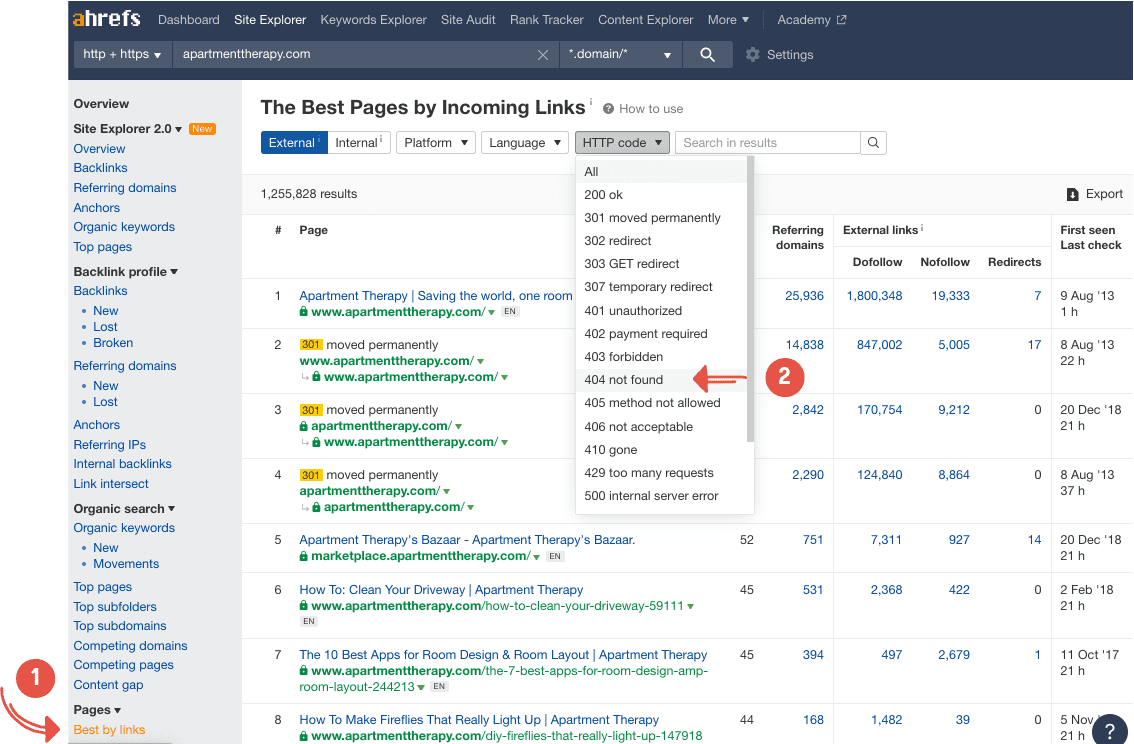
Look through the URLs to find a dead link that is relevant. Our window company finds a missing article about insulating windows for winter.
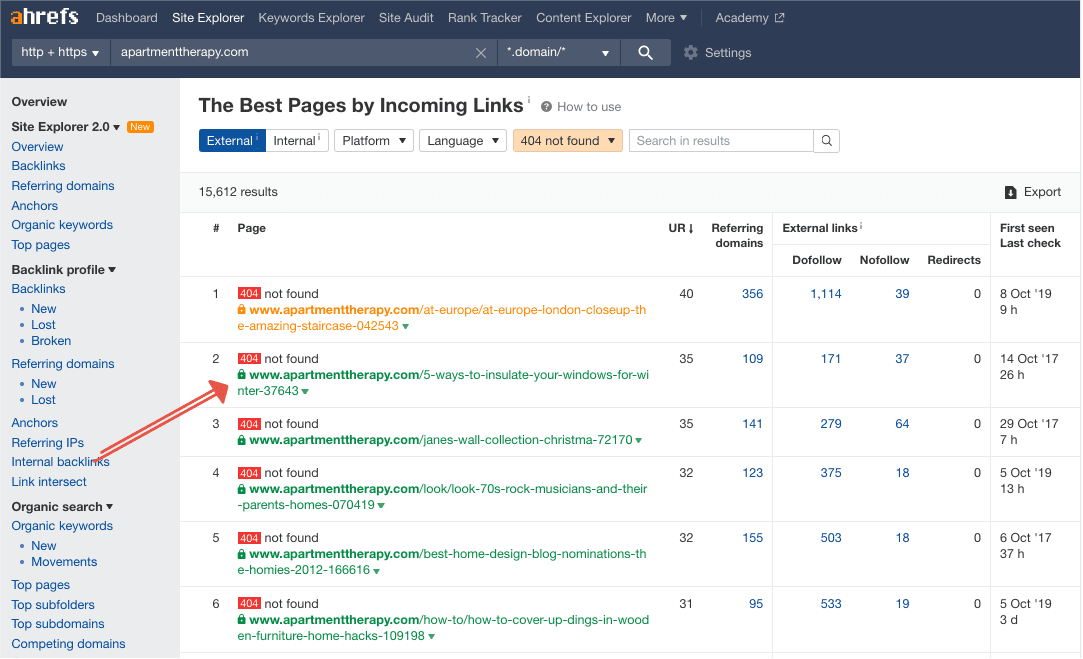
Now, enter this link into Site Explorer. The article on insulating windows has almost 350 backlinks from over 100 unique referring domains.

These are potential contacts you can reach out to for replacing the broken link.
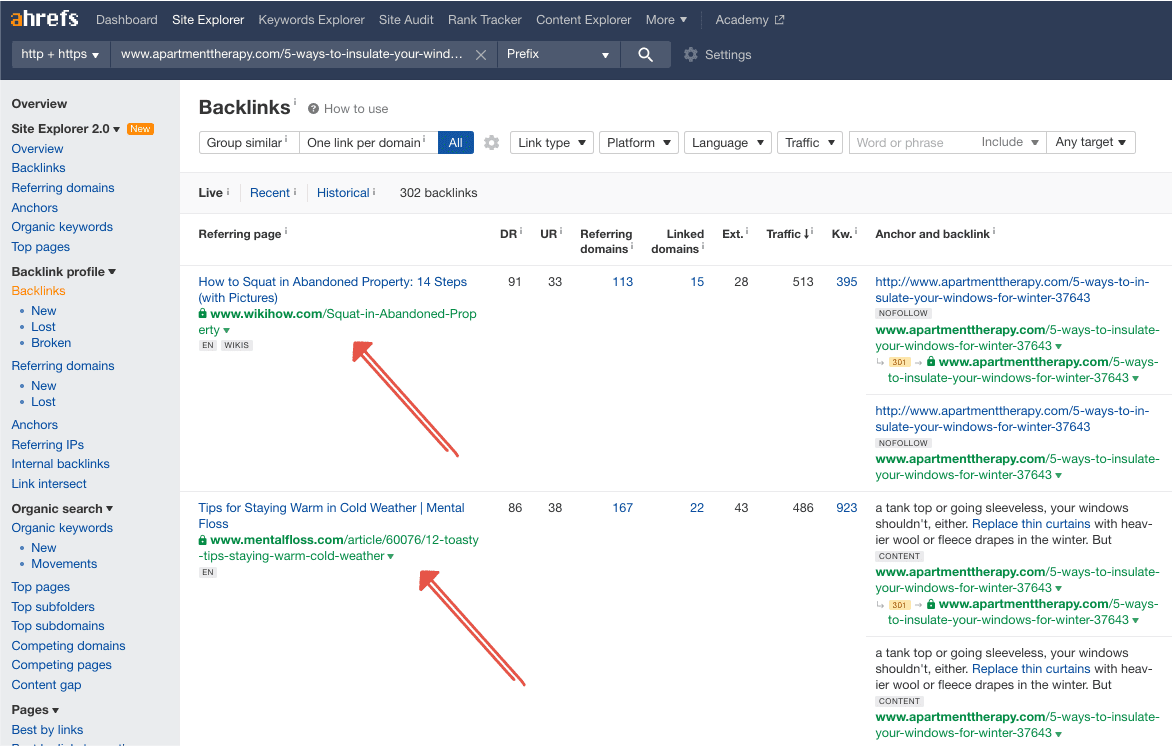
At this point, you can either skip ahead in this link-building guide to the step on creating replacement content or keep finding more prospects using keyword targeting.
Keyword Targeting
You can also find target websites using keywords. Start by listing the search terms you want to focus on. You might already have some good keywords that’ll work well for your site. You can also:
– Brainstorm keywords that are relevant and broad for your audience.
– Use a keyword research service to find terms customers might search for. Agencies can analyse user intent and better target keywords to your business.
Next, enter these keywords into Google to find sites your audience might visit. For example, a window company might target sites that rank for “window replacement” or “energy-efficient windows.”
Tip: Look for sites with many inbound links, as they are more likely to have dead links. Good target sites are authoritative and have many resources and links. They are popular for linking and can be hard to maintain due to the volume of links.
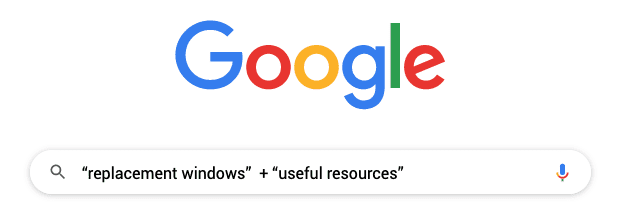
Reliable websites often use phrases like “related links” or “suggested resources.” To find these sites, combine your keywords with Google search commands, also known as search strings.
How to use Google search operators with keyword targeting
Most people type a few words into Google and press enter to search, but there are many commands that give more exact results.
Here are some useful ones for marketers:
- Quotation marks: If you search without them, Google shows results with the words but not always together. For instance, searching “replacement window” could find sites about replacement screens on windows. Use quotation marks around your whole phrase (“window replacement”) to get results with the exact phrase.
- intitle: Use this command followed by a term to find pages where that term is in the title, not just in meta tags. For example, “intitle:window replacement resources” finds pages titled “Window Replacement Resources”.
- inurl: Use this command followed by a term to find pages with that term in their URL. For instance, “inurl:resources” might show pages like example.com/resources.
- + (plus sign): Use it to include all search terms. It’s useful when you want results that meet all your search criteria.
Try these Google operators for targeted searches like “useful links” and “more resources”:
- “Keyword” + inurl:resources
- “Keyword” + intitle:links
- “Keyword” + “helpful resources”
- “Keyword” + “useful resources”
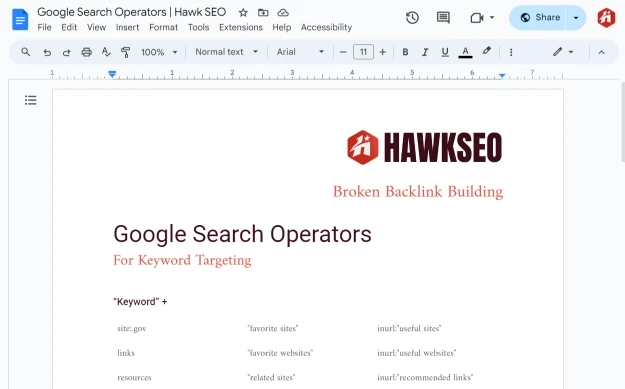
Our sample window company can use its keyword like this:
- “replacement windows” + intitle:links
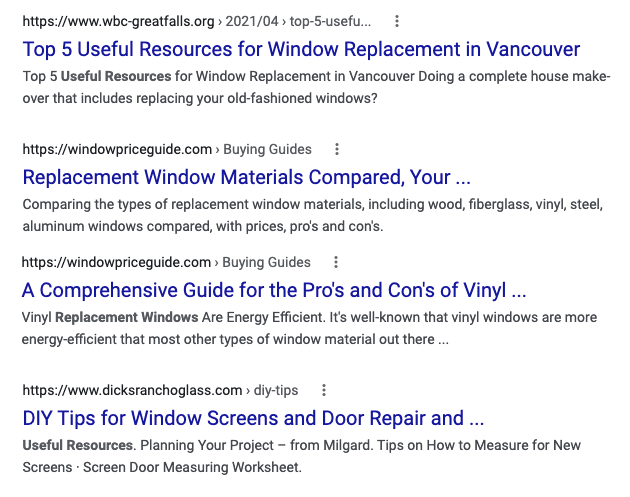
Now, look through the search results and add these target sites to your spreadsheet.
Find broken linking pages
When you’ve listed your target pages, the next step is to find broken links to these pages. You can use tools like Screaming Frog’s SEO Spider and Ahrefs Site Explorer.
Follow these steps, just like you did in the resource site targeting section above:
- Enter the URL of each target site from your spreadsheet into the SEO tool.
- Look at the site’s backlink profiles.
- Check the top pages by incoming links.
- Filter pages by HTTP code (404 error) to find broken links to your target page.
These are the sites you can contact to replace the broken link. Add these sites to your spreadsheet.
Match Your Content to the Broken Link
Now you’re ready to find content for each site you listed. Make sure the site is relevant and publishes content related to your business. Just finding a broken link isn’t enough; the content must be valuable to their readers for the site owner to link to your site.
What Kind Of Content Do They Need?
The easiest way to match content is to look at the original link. Is it an infographic, blog post, or video? What is the article about? Use this information to create similar content. If you can’t find the page on the site (sometimes it’s just moved to another section), try using the Wayback Machine, a digital archive that has saved over 600 billion web pages.

The Wayback Machine doesn’t have everything. If you can’t find the page, do a Google search for the domain. You can also check the original URL, as it might have part of the article’s title or the anchor text from the referring domain.
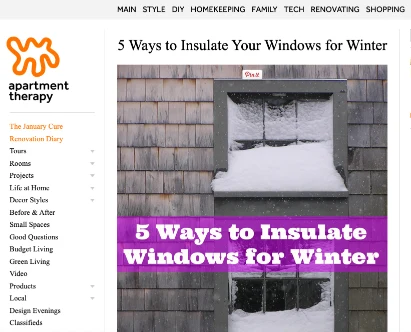
Match the Link to Your Existing Content
Once you know the type of content, look through your archives for a similar page. Don’t suggest linking to your home page or a sales page; the content must be helpful.
Improve the Quality of Content
Before sharing your content, review it carefully. If it’s a recent, well-written article, you can share the link as it is. However, if it’s from 2013, references outdated research, or is short, take the time to update it. It’s important to present your best work and make a positive impression when reaching out to a potential site for a broken link building outreach.
Here are some steps to follow:
- Focus on quality.
- Rewrite content if needed.
- Update statistics.
- Check that all internal links are working.
- Add new sections to provide more detailed information in the article.
Create New Content
Sometimes, it’s easier to use or change existing content than to create something new. But there are times when you don’t have the right article available. Here’s what to consider: Is the website valuable for a backlink? Is the topic interesting enough to justify creating a new piece? If so, it might be worth starting fresh to meet the need. At the very least, you’ll have a valuable addition to your own website.
There’s a chance you might not see immediate benefits, but you can maximise your time by:
- Targeting websites with many inbound links to expand where you can share new content.
- Optimising new content with keywords to boost your site’s authority and attract organic traffic.
Send an Outreach Email
When you’ve found good content for your prospect, it’s time to get in touch. Usually, you’ll need to do some digging to figure out who to email. It’s best to find someone who manages web content or does marketing.
Here’s how you can find the right person:
- Check the website. Look at pages like About Us, Contact Us, and Staff to find the right contact. Contact forms or general email addresses may not be as helpful. Try to find a specific person so you can personalise your email.
- Ask directly. If you only find a general email address, reach out and ask for the right contact. Make sure to include your full name, job title, and company details for credibility.
- Check social media. Some people list contact info on platforms like X or LinkedIn.
- Use email discovery tools. Try tools like Clearbit, Name2Email, or Snov.io; if you want to find emails associated with the company’s domain, consider Find That Email and if you’d like a list of available email addresses linked to the domain, try Hunter.
- Guess the email format. Many businesses use a standard email format (like first initial-last name). Use tools like Zero Bounce to verify the email before you send it.
- Consider outsourcing. If you’re short on time.
Finding the right person to contact takes a lot of effort, but it’s important to get your offer of help to the right people. If you have too many things to do, you might want to hire an SEO agency like Hawk SEO to help with link building services.
After you find their contact information, you can use a template email for broken link building outreach to offer your content.
Email Templates
Even though you want your outreach to be friendly and customised, using a template at the beginning can make the process easier and more organised.
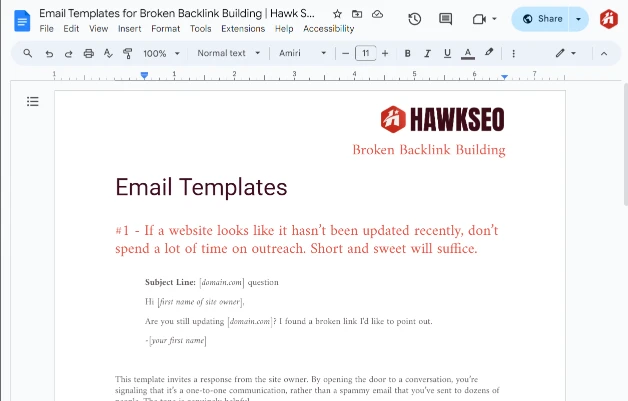
Leveraging Link Building Expertise
Broken links are everywhere on the internet. By following the steps in this guide on building links, you can turn some of these into links to your website.
If you have questions about link building, need assistance with finding keywords, or want to know more about our SEO agency, contact us for a free SEO consultation.







